Text: Hugo Boguslawski | Section: Articles by Artists
From 1991 to 2001, I studied not only art at Münster Art Academy, but also biology (albeit only through to completion of the foundation course in about 1995) at the University of Münster. However, I have retained my interest in biology. I have been living and working as a free-lance artist in Düsseldorf since 2001. Paleaontological Art reveals one of the focuses of my work.
Biology: my studies and thereafter
But why study biology? I obtained my “Abitur” (university entrance qualification) at a humanistic secondary school that specialised in not only the Classics (Latin and Greek), but also the natural sciences. Our enthusiastic biology teacher always had a number of voluntary assignments available for interested pupils, some of which touched on topics covered at university. I keenly seized the opportunities offered. I finally chose biology as one of my Abitur examination subjects, so it was only natural that I should later choose it as a subject to study.
At university, I was most interested in the morphology of zoological and botanical specimens, i.e. their internal and external structures. In about 2009, a friend kindled my enthusiasm for palaeontology, which is concerned with fossils, i.e. petrified organisms, and fossil collecting. This is where I could build on my existing knowledge. By studying current scientific publications, I immersed myself in the subject-matter. In addition, I eagerly read classical (antiquarian) literature, which I also found aesthetically appealing not least because of the hand-drawn illustrations.
Drawing on palaeontology and other sciences in my art
In my work as an artist I resort above all to palaeontology as an aspect of biology and geology. There are many areas here that I find interesting from the scientific and artistic points of view.
I have acquired a thorough knowledge of sedimentology (the science of the formation of sedimentary rocks) in order to understand the processes behind the formation of marine sediments and rocks. I also concern myself with stratigraphy (study of rock layers) and geochronology which seeks to explain how the rock strata are ultimately organised after millions of years of constant movement. To understand the structure of reefs, which contain a particular abundance of fossils, an understanding of palaeo-ecology (the study of fossilised habitats) is useful. I have also delved into evolutionary theory, which is concerned with the relationships between groups of organisms, and into the closely related field of genetics, i.e. the study of heredity.
The palaeontological literature also sheds light on mass extinctions. This phenomenon occurs more or less periodically and results in the mass disappearance of entire species and families, which is also known as a biotic crisis. This in turn results in a change in the composition of animal and plant life and in the renewed diversification and specialisation of the surviving species.
Artistic goals and background convictions
So what goals do I pursue when resorting to the research findings and methods of the sciences mentioned? Two factors are of special importance.
Firstly, I am fascinated by the morphology of individual fossil finds with their diversity of forms and perfect adaptation to the environmental conditions of their time. The complex compositions of animal communities and the location of the fossils in the rock embedding them today reveal a structure whose regularities and rhythms I adopt in my painting. The morphology and histology (study of tissue) of micro- and macroscopic specimens have found expression in my painting since studying biology at university.
Secondly, an understanding of the earth’s history and the development of life over millions of years puts the importance of mankind into perspective. In my art I therefore concentrate on the principal structures and regularities. I find inspiration in the extreme vulnerability and instability as well as the beauty and harmony of perfectly balanced ecosystems. And this is true not only of my works dealing explicitly with the thematic complex of palaeontology.
One point of departure of my structural painting has always been the landscape. In my works, the landscape appears in the following forms:
- a landscape – like structure vanishing in the haze or mist in the distance, a patch of ground viewed at an angle right at my feet, from a great height or in the ocular of a microscope (the structures of micro- and macrocosms are often similar)
- water surfaces, and also
- a horizonless underwater landscape, as encountered by divers.
I have been including palaeontological finds in my abstract, structural landscape pictures for a good 10 years. This was when I started to collect fossils, initially sporadically and then with growing interest and greater intensity – with the side-effects which should not be underestimated: planning, research, travel …
Collecting and travelling
The most productive sites for fossil collectors are in some cases awkward to reach and call for hiking, scrambling and unearthing. Since in Düsseldorf and environs there are only few outcrops – sites where fossiliferous rocks can be found at the surface – travel is necessary. The Eifel, Bergisches Land, Sauerland, the Swabian and Franconian Jura, the Harz, Thuringia, the Ardennes, Normandy (and particularly Calvados), Belgium and the Maastricht region, and various coasts of Denmark are areas to which the search for fossils has taken me.
The collector’s eye merges with the painter’s. “The untiring, persistent visual scanning of the topography […] is a continual exercise.” [1] This explains why it is not primarily the isolated fossils, but usually the entire find location together with the surrounding rock and landscape that becomes the subject of my pictures.
Examples of my works
Palaeontological art makes up only part of my work, but it is nevertheless important. In this article I am presenting the associated science-based work.
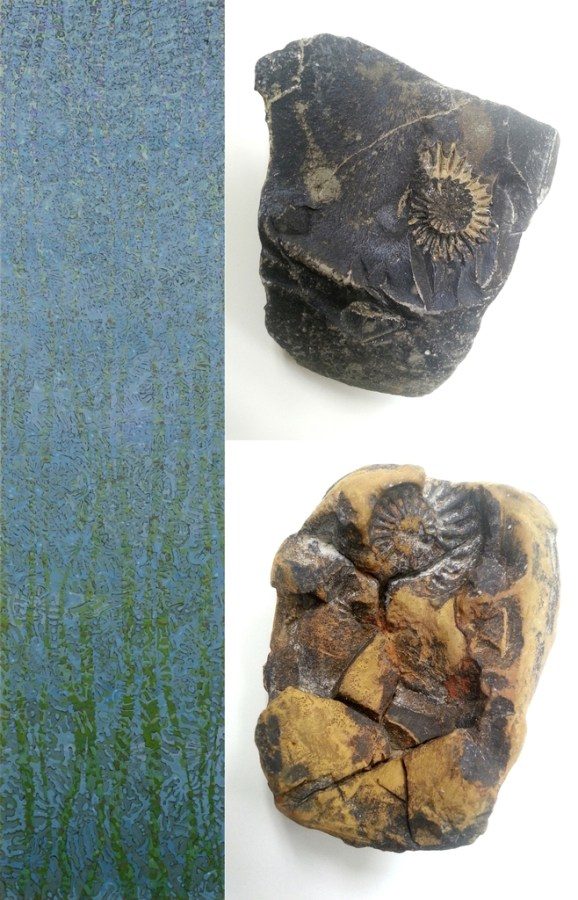
This work is inspired by items found in stream beds that I waded through at low water. In clayey or slaty ground, ammonites, belemnites (both are extinct groups of cephalopods to which today’s octopuses are related), shell-bearing molluscs, snails and terebratulids (an order of the largely extinct class of brachiopods) can be found.
Accidental structures in the rock, leaves and branches, the tread marks of my own boots and reflections of tree trunks and foliage, reflected light, and the patterns of the waves compose, on a variety of levels, a fabric of transient structures. The gaze trained on fossils discovers in the tread of a footprint the back of an ammonite, and in the veins of a beech leaf the ribs of a seashell.
Other examples: Stream in the wood – Traces in the water, late afternoon – Jurassic spirit.

This picture gains its inspiration from the find location of many Jurassic oysters and brachiopods bedded in a soft layer of clay close to the shore. This layer occurring at Falaises-des-Vaches-noir (Calvados) and Wimereux and Boulogne-sur-Mer (Pas-de-Calais) on the French Channel coast is only a few centimetres below the water’s surface at low tide and contains not only the above, but also many molluscs still in existence today along with typical mauve-brown seaweed. A certain quantity of water always oozes out of the clayey strata of the cliff, covering the beach with a wet film even at low tide and “combing” the seaweed in the same direction away from the shore. Another example: Wimereux (evening).
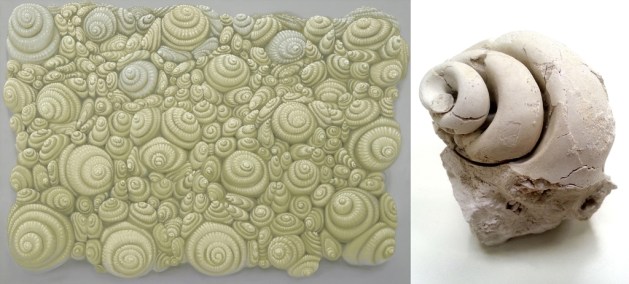

The picture shows an imaginary large slab of slate on which large fern fronds, horsetails (Equisetum) and other plant fragments have become impressed across the surface. Delicately raising the edges with lighter shades creates the illusion of a bas-relief. The picture is based on several smaller finds from the Carboniferous in the Ruhr valley region.
As described above, the landscape experienced by the walker also inspires pictures in which fossils only play a minor role:
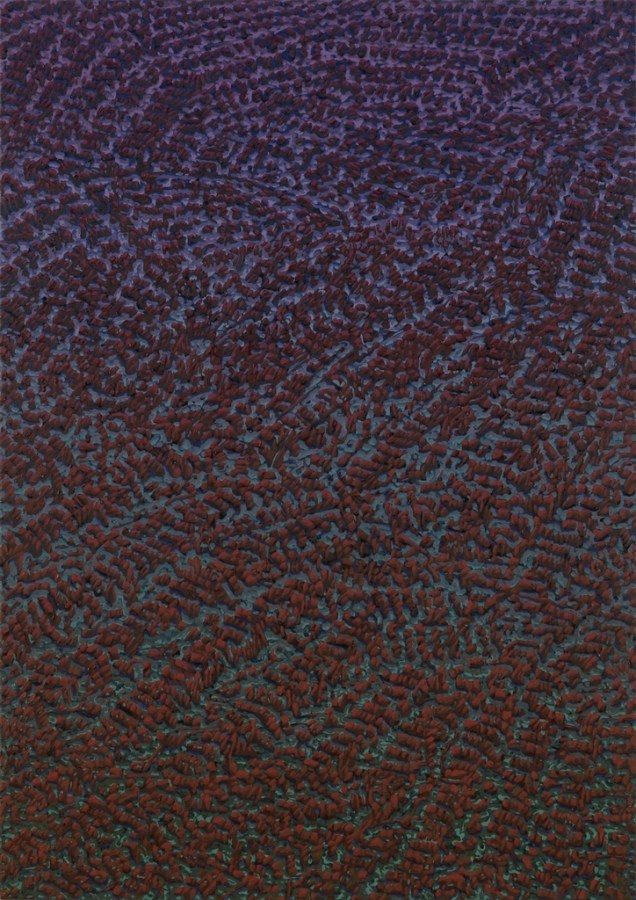
This picture is inspired by the Schöttelheide spoil heap in Bottrop-Grafenwald. The search for fern imprints had taken some time, and with the sun setting, dusk was approaching. The atmosphere conveyed by the light – weathered lumps of rock in the angled evening light – changed from one minute to the next. Spoil is still being dumped here from the last active hard coal mine, Prosper-Haniel, in the Ruhr valley region. This makes it one of the last spoil heaps still in use. The title Fading light can therefore refer not only to dusk, but also to the demise of hard coal mining. Other examples: Fading light (spoil heap) II – Fading light (spoil heap) III – Transition (fading light) 2013 – Transition (fading light) 2014 – On the Schöttelheide heap – “blue hour”.
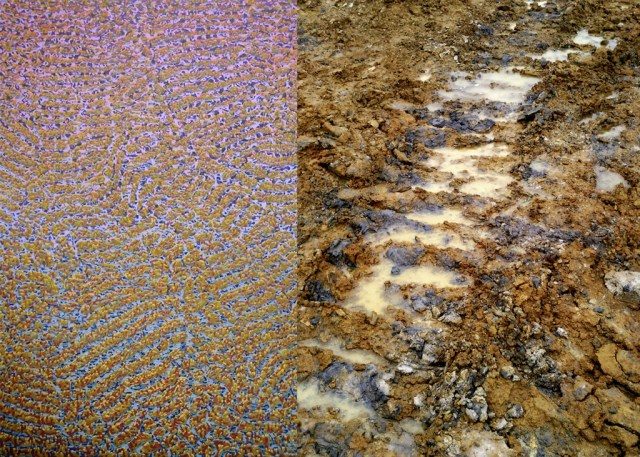

Étretat (Normandy) and Pointe aux Oies (Wimereux, Pas-de-Calais): these two pictures are inspired by the view from the water towards the shore. Beneath the water, the shadows suggest fossils as well as seaweed while the cliff is reflected on the water’s surface.

This picture was inspired by Møns Klint, Denmark’s highest cliffs on the island of Møn. The white chalk cliffs pervaded by bands of black flint contain Cretaceous sea urchins, oysters and belemnites. Abraded examples of sea urchins can be found under black-and-white striped pebbles in the wash margin. The view of the open sea from the shore. Another example: The Baltic at Møns Klint.
Mass extinctions have occurred at various times in the earth’s history. This phenomenon interests me both as a palaeontologist and as an artist. [2] The following picture addresses the mass extinction at the Cretaceous-Palaeogene boundary roughly 66 million years ago:
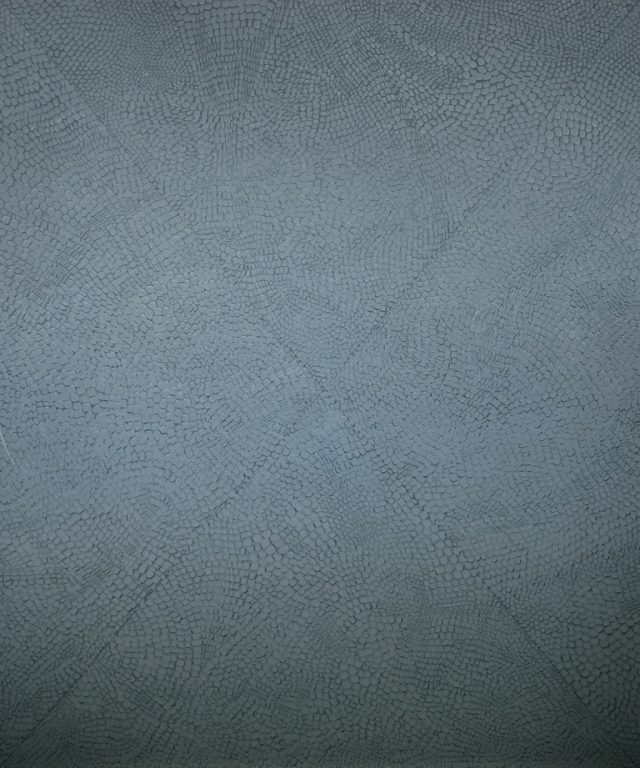
The picture represents areas of large pieces of dinosaur skin (hypothetically) sewn together to form an X. The dinosaur skin was modelled on bird’s leg leather (as used by model builders). Today’s birds are the direct descendants of a number of dinosaurs. The large X stands for Extinction.
The apparently relief-like surfaces are shaded towards the upper and lower edges. This imitates the lighting in the room and makes the surface appear slightly reflective. In this “mirror” the viewer can imagine his own reflection – and reflect on the finite nature of the entire Homo sapiens species in the mirror of all the other, already extinct species.
Finally, a picture that deals generally with the subjects of coral reefs, seaweed and plankton:

Other examples: Coral shadows – plankton.
Picture above the text of this article: Hugo Boguslawski: Carboniferous (2012). Photo: Hugo Boguslawski.
Translation: Tim Chafer, Düsseldorf
[1] Andreas Moersener: Ornamental – Hugo Boguslawski. Lippstadt 2011, p. 1.
[2] On mass extinctions, see Wikipedia
How to cite this article
w/k-Redaktion (2019): Palaeontological Art. w/k–Between Science & Art Journal. https://doi.org/10.55597/e3173
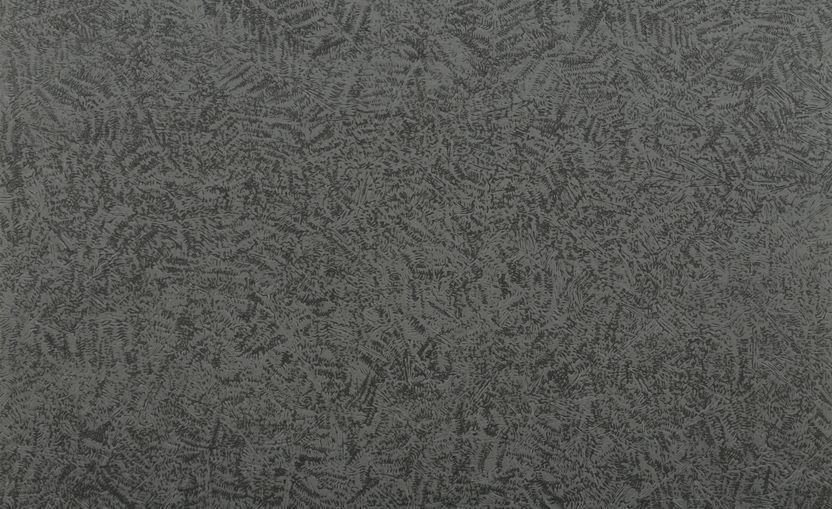

… [Trackback]
[…] Read More to that Topic: between-science-and-art.com/hugo-boguslawski-palaeontological-art/ […]
… [Trackback]
[…] Read More to that Topic: between-science-and-art.com/hugo-boguslawski-palaeontological-art/ […]